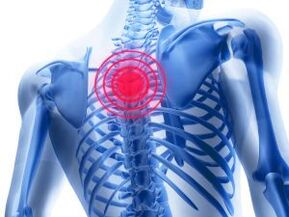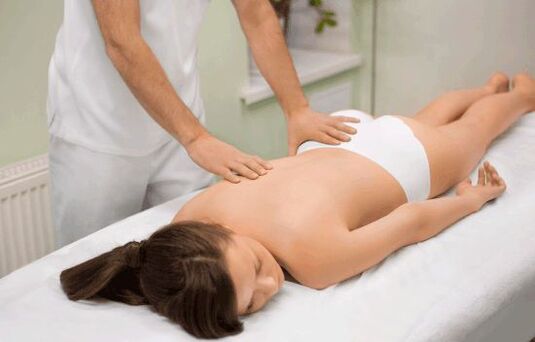
Clinically, thoracic osteochondrosis (chondrosis) manifests itself as sharp, piercing or dull, aching pains, clicks during bending and flexion, stiffness.
Characteristic and numerous specific symptoms for the pathology are shortness of breath, discomfort in the heart area and even sore throat.
Treatment of the pathology is mainly conservative with pharmacological drugs. Physiotherapy procedures, massage sessions are also performed and chiropractors are used.
If such treatment is ineffective, the patient undergoes surgery.
Details of symptoms
Symptoms of thoracic lumbar osteochondrosis never appear overnight. In the early stages of the development of this degenerative-dystrophic pathology, only a slight discomfort is noted in the back. Patients suffer from banal fatigue after a hard day's work, "stiffening" the muscles due to staying in one position for a long time.
However, the intensity of anxiety is slowly increasing. Unpleasant feelings are replaced by severe pain complicated by limited movement, dizziness and headaches. In medicine, all the symptoms of osteochondrosis of a certain localization are divided into several groups. This helps to diagnose faster and determine treatment tactics.
Note!Symptoms of thoracic osteochondrosis in men and women do not differ in nature, severity and localization. However, in the stronger genitals, they may appear later due to the stronger musculoskeletal system. In addition, some men have erectile dysfunction on the background of osteochondrosis.
Vertebral symptoms
Under the influence of adverse factors (hypothermia, increased physical activity), long-term remission of thoracic osteochondrosis can be interrupted by a sudden onset of acute pain. More often, it causes the body to remain in one position for a long time, such as sitting. If a person suddenly gets up, there is such a sharp pain in his back that he loses the ability to move for a few minutes.
In medicine, this condition is called dorsago. It differs from ordinary pain with concomitant symptoms:
- feeling short of breath;
- severe stiffness.
The course of the pathology is often complicated by dorsalgia - thoracic back pain, the intensity of which gradually increases. It grows by turning the body to the sides by bending. In order not to experience pain, a person takes a forced position. At the same time, it involuntarily tenses the back muscles, inevitably causing them to overload. Now they are offended when they start walking.
Extravertebral symptoms
As thoracic osteochondrosis develops, the intervertebral discs become thinner and more destroyed. These cartilage pads are no longer able to distribute the loads created, eliminating the impact of the vertebrae on each other. The body's compensatory response is triggered - bone structures begin to deform as growth occurs. They compress the sensitive nerve endings by disrupting the spinal canal. Therefore, women and men have specific symptoms of thoracic osteochondrosis: loss of sensitivity of certain parts of the body, a burning sensation and creeping "gas shocks".
It is important! Osteochondrosis of the thoracic localization is often manifested by dry, unproductive cough, sore throat, coma and urinary disorders.
But that's not all. Spinal roots are responsible not only for the innervation of the spine (transmission of nerve impulses), but also for the internal organs. Therefore, when it is disturbed, unpleasant sensations arise from the liver, kidneys, digestive system, myocardium. What are the non-specific symptoms of lumbar pathology with thoracic osteochondrosis:
- pain in the heart area, shortness of breath, a feeling of "compression" of the heart, which is the same as the recurrence of angina pectoris;
- panic attacks, psycho-emotional instability, unreasonable fear, anxiety, sleep disorders;
- causes discomfort, nausea, sometimes vomiting, sour itching, swelling, seething and rumbling in the epigastric region;
- disturbance of peristalsis - constipation or diarrhea;
- sobbing-sobbing crying breaths.
The pain is not directly localized at the site of the destroyed intervertebral disc and (or) the resulting intervertebral hernia. They spread along the nerve. Symptoms of osteochondrosis of the thoracic region can be disguised as renal colic, gastritis, gastric ulcer, hepatitis, pancreatitis, cholecystitis and even gastroenteritis.
Compression myelopathy
This is the name of extravertebral syndrome, which is rare in clinical practice. Due to the loss of stability of the vertebral segment, the pulposus nucleus is observed in stages 3-4 of the disease when it reaches the edge of the ring fibrosis. An intervertebral hernia is formed that constantly buries the spinal cord. At the appointment with a vertebrologist or neurologist, patients often complain of abdominal pain that spreads to the groin area. At the same time, there is a feeling of weakness and numbness in the lower extremities.
Against the background of spinal cord damage, innervation is severely impaired. In the absence of treatment, the functional activity of the organs located in the small pelvis decreases. Compression myelopathy causes problems with bowel movements. The sensitivity of the legs decreases due to the obvious narrowing of the diameter of the spinal canal. In severe cases, patients are diagnosed with paresis (partial or complete paralysis) of one or two lower extremities.
Symptoms of remission
Outside of recurrences, thoracic osteochondrosis hardly bothers a person. Sometimes there is a dull, aching, dull back pain and usually disappears after a long rest. In the next repetition, it is worth increasing the load on the spine at least slightly, lifting something heavy or bending. Factors such as:
- stressful situations, depressive states;
- hypothermia, sudden temperature changes;
- staying in one position of the body for a long time;
- alcohol abuse;
- unbalanced diet, lack of foods high in calcium, phosphorus, manganese, molybdenum in the diet.
Sometimes the remission phase ends because the person is trying to prevent another relapse. Visit a chiropractor or massage therapist with a dubious reputation or little practical experience. Attempts to stretch the spine cause another flare-up.
Basic treatment methods
It is not yet possible to completely cure the pathology, so all the efforts of doctors are aimed at improving the patient's well-being. Patients are advised to wear orthopedic products (corsets, bandages) that correct vertebral structures and prevent their movement. Drugs of different clinical and pharmacological groups are prescribed, physiotherapeutic measures and physiotherapy exercises are carried out.

The movements of the chiropractor's hands are aimed at increasing the gaps between the vertebrae, which are reduced in thoracic osteochondrosis.
It is important!Conservative treatment is useless in high-grade thoracic osteochondrosis. Patients are offered immediate surgical intervention - removal of the intervertebral hernia, arthrodesis, placement of implants in place of the damaged disc, bone grafting.
Drug treatment
Treatment of thoracic lumbar osteochondrosis aims to eliminate all symptoms and prevent destructive and degenerative processes. During the period of exacerbation, solutions are used for parenteral administration, which act after 5-10 minutes. Then the result is strengthened by taking a course of tablet preparations, applying ointments and gels. In the remission phase, external means are used, which have a milder effect on the body.
Non-steroidal anti-inflammatory drugs (NSAIDs)
This is the most widely used group of drugs in the complex treatment of thoracic osteochondrosis. Their active ingredients inhibit the biosynthesis of pain, inflammation and fever mediators from arachidonic acids. Even after using NSAIDs, a person's well-being improves significantly:
- the severity of the pain syndrome decreases;
- the unpleasant crisis that occurs when the body turns and bends disappears;
- weakens inflammatory processes in soft tissues, edema resolves;
- the range of motion in the thoracic region increases.
Intramuscular solutions are used to stop recurrences. The drugs in capsules or tablets can cope with moderate pain. And ointments and gels quickly eliminate mild discomfort.
Preparations containing B vitamins
Drugs containing B vitamins are good for innervation disorders. Improves the transmission of nerve impulses to the central and peripheral nervous systems, stimulates the regeneration of damaged spinal roots. The composition of the funds is represented by thiamine, riboflavin, pyridoxine, cyanocobalamin.
In the first week of therapy, in addition to vitamins, intramuscular administration of drugs containing lidocaine, which immediately relieves pain. And then, patients are shown to take the pill for a month.
Glucocorticosteroids
The use of these synthetic hormone analogues, produced by the adrenal glands, is used when safer means are ineffective. Glucocorticosteroids are prescribed to patients with acute low back pain and radiation to internal organs. Medications can be taken orally, but more often are given parenterally, including destroyed discs.
Glucocorticosteroids have a wide range of contraindications and potential side effects. Long-term treatment of thoracic lumbar chondrosis with hormones causes damage to the liver, kidneys and stomach tissues. It is contraindicated in patients with cirrhosis, peptic ulcer disease, renal failure and osteoporosis.
Muscle relaxant
Low back pain is often associated with increased skeletal muscle tone. Muscle relaxants are used to relieve it - first in the form of a solution for parenteral administration, and then in tablets. Medications relieve muscle spasms that cause spinal cord compression. Which muscle relaxant is most effective:
- blocking of polysynaptic reflexes;
- relaxing spasmodic muscles;
- reduces the release of prostaglandins.
Medications are rarely used for monotherapy. Chest chondrosis is treated with glucocorticosteroids or non-steroidal anti-inflammatory drugs with muscle relaxants. Their significant drawback is the very rapid formation of addiction, so their use is prohibited for more than a week.
Chondroprotectors
Unlike drugs that relieve the symptoms of osteochondrosis of the chest, such drugs are also used for pathogenetic treatment. This is the only group of drugs that can increase the production of chondrocytes, which are needed for the partial repair of cartilaginous intervertebral discs. All therapeutic effects of chondroprotectors are associated with high levels of glucosamine and / or chondroitin.
But chondroprotectors are valued not only for their ability to repair discs. Their components glow in the area of the damaged vertebral segment. After 2-3 weeks, the maximum therapeutic concentration of glucosamine and chondroitin is reached. Now the drugs are clearly analgesic, anti-inflammatory, anti-edematous.
Recommended!It is recommended to treat osteochondrosis with chondroprotectors in the form of injectable solutions or tablets. Despite all the beliefs of manufacturers about the effectiveness of ointments and creams, they could not provide evidence for their therapeutic effectiveness.
Non-drug treatment
Treatment of osteochondrosis of the thoracic region with pharmacological drugs must be combined with regular physical activity. Exercise therapy is the most effective treatment for disability. Daily exercise strengthens the lumbar muscle frame and the garden-tendon apparatus of the thoracic region, improves the production of synovial fluid that nourishes the vertebral structures. The set of exercises is prescribed by a training therapy physician after studying the results of X-ray diagnostics. Participates in first grades, monitors the dose of loads.
Manual treatment of osteochondrosis is also used to increase the gaps between the discs and the vertebrae. The spine is pulled (pulled) dry or underwater, and at home - hung on a stick. The effectiveness of manual therapy increases simultaneously with physiotherapy:
- electrophoresis;
- laser therapy;
- magnetotherapy;
- ultraviolet radiation;
- diadynamic currents.
Patients are shown 10-15 sessions of classic, vacuum, Scandinavian, acupressure. Spa treatments with hirudotherapy, acupuncture, radon and hydrogen sulfide baths are also helpful.
Only with an integrated approach to the treatment of thoracic osteochondrosis is it possible to rule out further disc damage and vertebral deformity. Following the doctor's advice helps to get rid of all the symptoms of chronic pathology as soon as possible.












































